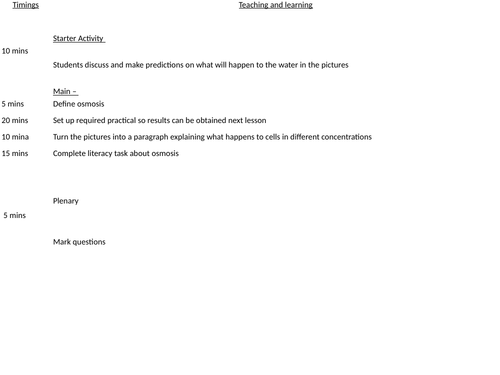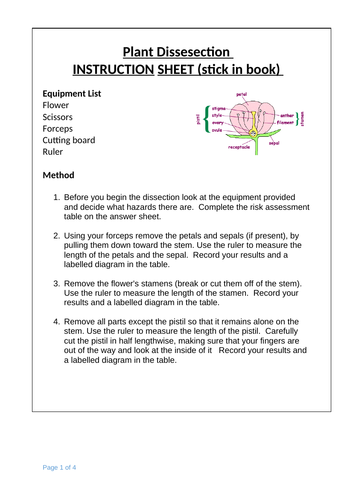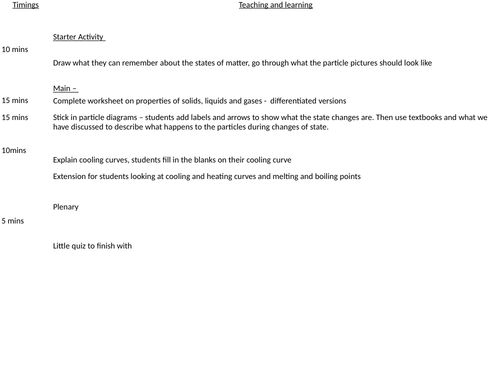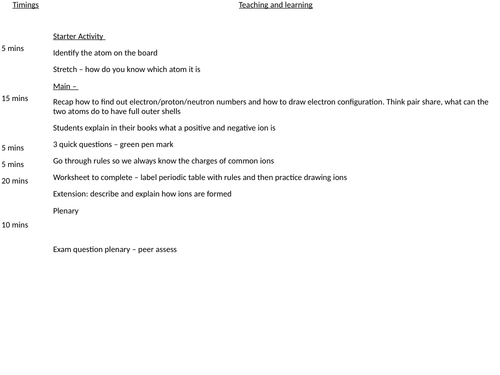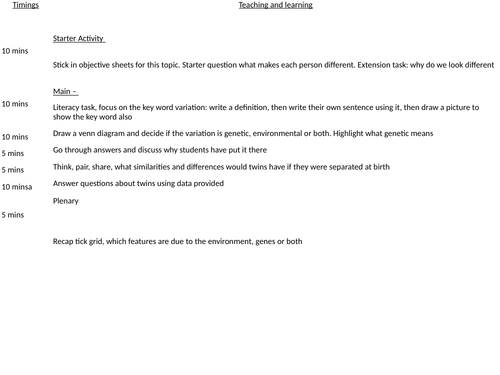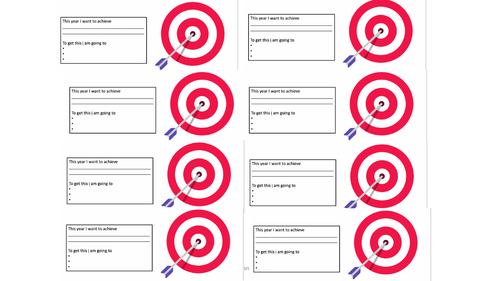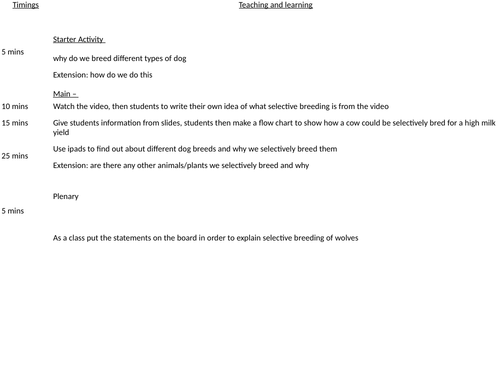
124Uploads
30k+Views
8k+Downloads
All resources

Filtering and evaporation KS3
Aimed at mixed ability year 8 - Some resources from TES
L1 - Starter: thinking about what sea water contains
Main: Think pair, share how to separate sea water
introduce key words
write a method/risk assessment for practical
Plenary: particle diagram of what happens during filtering
L2 - Main label equiptment in the diagrams and mark
Main: complete rock salt practical
Differntiated bronze/gold worksheets for students to work their way through
Plenary: one thing students learnt today
Marking sticker provided for the practical, if you wish to level the students work

Microscopes KS3
Aimed at a mixed ability year 7 class
5 mins
Differentiated questions to see what students know already about the microscope
Main
History of the microscope task – HA/LA version HA comprehension task about history, LA cut and stick to put in order
Show students parts on real microscope then cut and stick activity to label microscope parts – HA/LA version available as well as support sheets - go through answers
Extension: magnification calculations
Plenary
5 mins
Tweet something you have learnt today

B1.7 Osmosis
Aimed at a mixed ability year 9 class
Starter: Discuss and make a prediction about where the water willl move
bring it together with a definitoin of osmosis
Main: Set up practical so results can be looked at next lesson - method on slide
go through what happens to cells in different concentrations
differentiated literacy task
Plenary: mark questions

B1.10 exchange materials
Aimed at a mixed ability year 9 class
Starter: reflect on previous diffusion practical
Main: explain surface area:vol, do practic equestions and mark
do research task to explain how surfaces are specialised
extension: checkpoint follow ups from kerboodle
Plenary" tweet what theyve learnt

C1.2 Chemical equations
Aimed at a mixed ability year 9 class
Worksheets are from TES
Starter Activity
Answer starter questions
Main –
Go through state symbols, make a note of what each means
Explain the conservation of mass – need to write down the defintions
Stretch: why do some reactions appear to gain/lose mass
Go through steps on how to balance equations. Supporting worksheets to build up. Make sure there is an emphasis on what the ‘big’ and ‘little’ numbers mean. Do examples at each step, then get students to complete the rest
Extension sheet of harder equations to balance for students flying through
Plenary
Plenary – make rules for balancing equations

C1.4 fractional distillation and paper chromatography
aimed at a mixed ability year 9 class
Starter Activity
Match key words to definitions – go through answers
Main –
Students watch demo of fractional distillation. Explain uses/whats happening at each point. Students the write an explaination of how they can obtain pure ethanol
Set up chromatography experiment, whilst waiting for it to develop write a step by step method for the practical. Go over basics, this will be revisited as chromatography is a required practical.
Plenary
Tweet one thing they have learnt today

C1.7 Ions, atoms and isotopes
aimed at mixed ability year 9 class
Starter Activity
Differentiated Bronze/silver/gold questions from previous lesson
Main –
Think, pair, share – how big is an atom. Copy down the size of an atom and nucleus intho their books
Copy key words need to be able to define ion and isoptope for level 4
Explain that atoms can lose or gain electrons. And what happens if they do. Students make notes on this, then go through a few examples.
Students practice working out electron/proton/neutron for ions
Extension task for students who finish
Explain what an isotope is, do one worked example of finding proton/neutron numbers then their go at finding how many protons and neutrons are in carbon isotopes
Exam practice if time
Plenary
Identify whether the pictures are atoms, ions or isotopes

Structure of a plant
Aimed at KS3 students.
This lesson recaps KS2 prior knowledge on the structure of a plant. Before moving onto KS3 content about structure and function of parts of the plant, followed by a plant dissection, accompanied by worksheets.

Pure and Impure
Suitable for KS3
Includes:
Recall starter
Pure and impure including particle diagrams
Pure and impure boiling points
practical investigation to investigate purity

C1.6 structure of the atom
aimed at a mixed ability year 9 class
Starter Activity
Put atom structures in the correct order thinking back to last lesson
Main –
Work through work sheet in steps. To ensure maximum understanding
Chase the element – race task to find out what each element around the room is, identifying proton neutron and electron number and matching it with an element on the periodic table
Make a model of an atom using string, and card (cut card into circles use string to attach them together)
Plenary
Tweet what you’ve learnt tday

C3.1 States of matter - Foundation
Aimed at a foundation class
Starter Activity
Draw what they can remember about the states of matter, go through what the particle pictures should look like
Main –
Complete worksheet on properties of solids, liquids and gases - differentiated versions
Stick in particle diagrams – students add labels and arrows to show what the state changes are. Then use textbooks and what we have discussed to describe what happens to the particles during changes of state.
Explain cooling curves, students fill in the blanks on their cooling curve
Extension for students looking at cooling and heating curves and melting and boiling points
Plenary
Little quiz to finish with

C3.2 atoms into ions - Foundation
aimed at a lower ability class
Starter Activity
Identify the atom on the board
Stretch – how do you know which atom it is
Main –
Recap how to find out electron/proton/neutron numbers and how to draw electron configuration. Think pair share, what can the two atoms do to have full outer shells
Students explain in their books what a positive and negative ion is
3 quick questions – green pen mark
Go through rules so we always know the charges of common ions
Worksheet to complete – label periodic table with rules and then practice drawing ions
Extension: describe and explain how ions are formed
Plenary
Exam question plenary – peer assess

C3.5 covalent bonding - foundation
aimed at a lower ability class
Starter Activity
Mark homework
Main –
Think pair share – spot the difference between ionic and covalent bonding. Then write down definition of covalent bonding
Watch video, only watch until 2 minutes. Answer questions whilst video is going. Goo through and green pen answers after
Go through the two examples on the board and show what happens
Students then have a go at completing their worksheet to show covalent bonds
Extension: decide if the compounds are ionic or covalent and explain how they know
Plenary
Plenary, fill in the gaps and go over answers

C3.4 Giant ionic structures - foundation
aimed at a lower ability class
Starter Activity
Using previous knowledge make predictions about ionic compounds
Main –
Go through and discuss giant ionic lattices
Students move around the room to find the information sheet to find out if there prediction was correct or not and why
Practical with a dissolved ionic compound to show it can conduct electricity. Make sure say that molten ionic compounds too and what a molten ionic compound is
Plenary
Exam question plenary

B13.1 variation and evolution
Aimed at a low ability class.
Starter Activity
Stick in objective sheets for this topic. Starter question what makes each person different. Extension task: why do we look different
Main –
Literacy task, focus on the key word variation: write a definition, then write their own sentence using it, then draw a picture to show the key word also
Draw a venn diagram and decide if the variation is genetic, environmental or both. Highlight what genetic means
Go through answers and discuss why students have put it there
Think, pair, share, what similarities and differences would twins have if they were separated at birth
Answer questions about twins using data provided
Plenary
Recap tick grid, which features are due to the environment, genes or both

B13.2 Evolution by natural selection
Aimed at a low ability class
Starter Activity
Pictures of animals with the albinism mutation, students decide if they think this is beneficial or not and explain their answer
Main –
Think pair share for one minute to discuss the word mutation. Then do a vocab lab for the definition
Fill in the blanks about mutations, print for LA students
Watch video about Charles darwins natural selection. Then cut and stick the statements into order to describe natural selection. Green pen mark
Explain how the lion is adapted and how these adaptations are beneficial.
Complete exam questions. Extension question available on powerpoint.
Plenary
Mark exam question

B13.3 selective breeding
Aimed at a low ability class
Starter Activity
why do we breed different types of dog
Extension: how do we do this
Main –
Watch the video, then students to write their own idea of what selective breeding is from the video
Give students information from slides, students then make a flow chart to show how a cow could be selectively bred for a high milk yield
Use ipads to find out about different dog breeds and why we selectively breed them
Extension: are there any other animals/plants we selectively breed and why
Plenary
As a class put the statements on the board in order to explain selective breeding of wolves

C11.4 global climate change
Aimed at foundation students targets of level 4
Starter: differentiated bronze/silver/gold starter based on previous lessons in the topic, answers on following slide
Main:
Watch video, write a list of as many problems form global warming
think, pair, share: what is a a carbon footprint - write defintion
discuss what the different countries of the world are trying to do to combat global warming
Students fill in an information sheet from what they have learnt, differentiated extension questions with answers if students complete
Plenary: higher or lower, interactive, do you think the following country has a higher or lower level of renewable energy use



